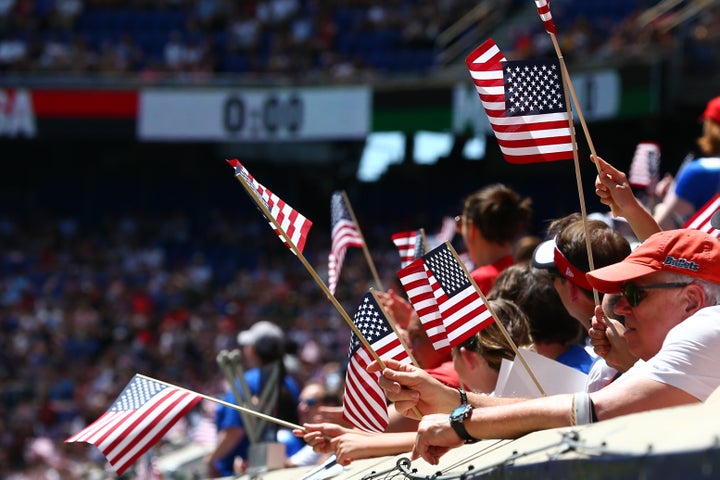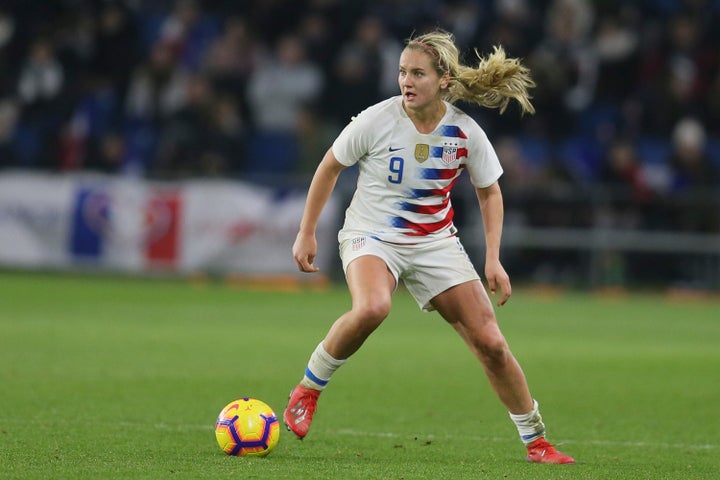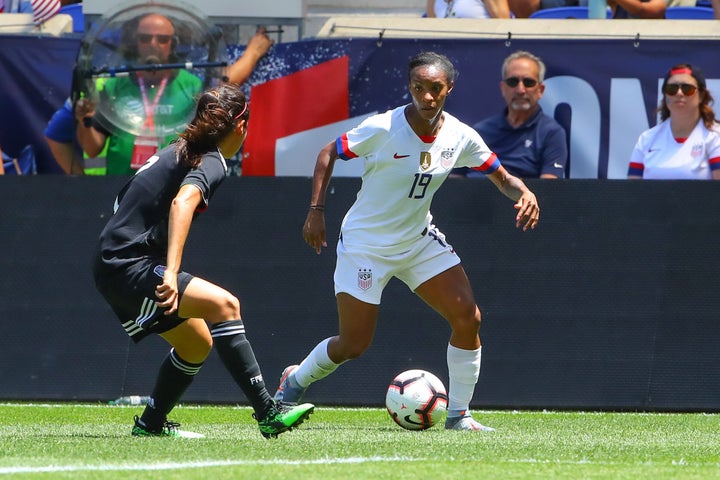Four long years after dominating Japan to win their third World Cup crown the United States Women’s National Team will finally begin their title defense on Tuesday. The United States faces Thailand to open the tournament, beginning play in a group that also features Chile and the Americans’ longtime nemesis, Sweden.
The United States is once again entering the World Cup as the world’s top-ranked team and the odds-on favorite to win it all, but to do so, the USWNT will have to weave its way through the deepest and most talented field in women’s soccer history.
Manager Jill Ellis’ roster features a number of players who helped lead the U.S. to the title four years ago, including striker Alex Morgan, Becky Sauerbrunn and 2015 hero Carli Lloyd, who scored a hat trick against Japan in the final four years ago. But it also includes a litany of new names who have emerged as potential stars and will play vital roles in the American team’s effort to defend the title.
Here’s a look at why the United States will ― or won’t ― win their fourth World Cup title in France, and at a few key players whose performances will determine how far the Americans advance.
The Schedule
U.S.-Thailand, Tuesday, June 11 (3 p.m. ET/Fox)
U.S.-Chile, Sunday, June 16 (noon ET/Fox)
U.S.-Sweden, Thursday, June 20 (3 p.m. ET/Fox)
Why They’ll Win
The overall level of talent has improved across the women’s World Cup field, but the United States is still probably the sport’s deepest and most talented team, top to bottom. Nowhere is that more true than in the attack: While a host of teams can rival the quality of the United States’ starting front line, none can boast the seven-deep attacking unit that Ellis has available to her.
Morgan, who scored her 100th international goal this spring, will lead the American forward line alongside dynamic wingers Tobin Heath and Megan Rapinoe. Behind them, Ellis can turn to Christen Press or Mallory Pugh ― a potential breakout star ― or Lloyd, who scored six times at the World Cup four years ago, for reinforcements or tactical shifts. Throw in Jessica McDonald, the leading American-born goal scorer in National Women’s Soccer League history, for good measure.
The Americans also utilize forward-minded players at both fullback positions (Kelley O’Hara and converted striker Crystal Dunn) and across the midfield. And while it’s not always pretty ― at times the midfield hasn’t always been in sync with the attack ― the sheer depth and quality up front can wear down opposing defenses. They might have to: The strength of the U.S. team’s defense is an open question, and it struggled against fellow World Cup contenders in international competition this spring, so the Americans may find themselves in a wide-open match or two that requires them to win a high-scoring slugfest. They’ve proved capable of that, though: The U.S. outlasted Australia, 5-3, in April, though preferably they’d avoid any such shootouts in France.

Why They Won’t
The Women’s World Cup has had only one repeat champion, when Germany defended its title in 2007, so there’s a bit of history running against the USWNT even before the tournament starts. But there are plenty of other reasons to think that the United States, while ranked No. 1 in the world, will fall short of another World Cup title. The defense. The midfield. The talent of other teams. A potentially deadly draw, especially in the group stages. Take your pick.
For all of the USWNT’s attacking verve, there are question marks aplenty about what happens when other teams attack them. O’Hara, who’ll start at right back, has been hampered by an ankle injury over the last few months, and Dunn, her counterpart at left back, is a converted attacker, not a true defender. Sauerbrunn is back again to start at center back, and while her likeliest back-line partner ― Abby Dahlkemper ― is super-talented, this is her first World Cup. Same goes for goalkeeper Alyssa Naeher, who was on the roster in 2015 but didn’t play. The U.S. struggled to keep quality opponents off the scoreboard early in 2019, conceding seven times in three matches against England, Australia and Japan this spring. They were better in World Cup tune-ups ― the U.S. hasn’t conceded a goal in four matches since shipping three to the Aussies in March ― but those matches were against lesser foes. The Americans like to dominate the ball and attack at will, but eventually they’re going to run into the sort of teams capable of punching back.
The midfield has the ability to help out the back line, thanks to Lindsey Horan and Julie Ertz, two players capable of winning the ball and keeping opposing attacks at bay. But even the more defensive-minded Ertz, who played center back for the 2015 champions, isn’t a traditional holding midfielder, and there’s only one of those on the roster. Ellis has also experimented with the midfield shape and personnel throughout 2019, and at times, the U.S. has felt a little adrift in the middle of the park, simultaneously vulnerable to counterattacks and less than stellar in its ability to feed its stable of forwards. Rose Lavelle, who’ll sit ahead Horan and Ertz in a midfield trio, will need to provide the creative spark she’s capable of to release that talented front line. They’ve looked better on that front in recent matches, too, but still Rapinoe and other veterans have worried that the U.S. isn’t patient or sharp enough in building up to its attack.
Maybe the biggest worry, though, is just how good everyone else is. The United States has never gone out of a World Cup before the semifinal, but even if everything breaks the Americans’ way in the group stage, that’s entirely possible this year. Thanks to the draw, the U.S. will likely play France in the quarterfinals, a matchup that would see off one of the tournament’s three early favorites relatively early on. But that’s only the beginning: A potential run to the final could take the United States through each of France, England and Germany ― three of the world’s top four teams. (The U.S. lost to France, 3-1, in January and drew England, 2-2, in March.) That’s a tough path that doesn’t even account for the quality of the World Cup’s middle tier of potential surprise contenders. Lose the final group stage match to Sweden, and the U.S. could find itself playing Germany ― the world’s second-ranked team ― in the quarterfinal instead. Any possible road to another title is probably the toughest the U.S. will have ever traversed.
Opening matches against relative minnows (Thailand and Chile) should, in theory, give Ellis and the Americans time to work out kinks in the midfield and round into shape for the knockout rounds. If Ellis gets it right, the questions about the defense and midfield, while legitimate, could amount to nothing more than nervous fans of a quadrennial favorite trying to poke holes in Ellis’ roster. But the development of the women’s game worldwide, and especially in Europe, has made those questions more pertinent than ever and winning the World Cup that much harder than it already was. The World Cup is meant to be lost more than it’s won, and this field is deep enough that the United States could find itself on the wrong end of a result even on a good day.

Five Players To Watch
Some of the biggest stars from 2015’s World Cup-winning side are back, but if the United States is going to repeat as champion, they’ll need these five players ― some making their World Cup debuts, and others playing bigger roles than ever ― to star.
Tobin Heath: Heath is a World Cup regular at this point ― she made four appearances in 2011 and started five of seven games in 2015 ― but over the last four years she’s blossomed into one of American soccer’s biggest stars. Heath is among the sport’s most technically gifted players, capable as she is of turning defenders inside-out whenever she wants, sometimes without even touching the ball.
But if that creativity once made her a fine component of American teams, it’s her completeness as a goal-scoring threat and assist machine that has made her absolutely vital to the USWNT’s World Cup hopes now. Heath, who’ll start next to Morgan down the right wing, isn’t just one of the American team’s most fun players to watch anymore, she’s probably its most important player, period.
Lindsey Horan: Horan is the rock in the center of Ellis’ midfield, a legitimate force and reigning National Women’s Soccer League Most Valuable Player who could become a superstar on the world stage in France. Horan is the sort of two-way force that’s vital to a team that wants to attack at all times but also has to defend at some point. She’s creative going forward but also rock solid: As SB Nation’s Kim McCauley noted, Horan won 321 duels with opposing players last season in the NWSL, an astounding 116 more than anyone else in the league. Horan isn’t as much of an offensive threat in Ellis’ system as she is in the NWSL, but for a side that doesn’t play a traditional defensive midfielder, her ability to win the ball and stop opposing counterattacks before they start might prove even more important.
Alyssa Naeher: A wild stat, courtesy of Yahoo’s Caitlin Murray: Only two goalkeepers have played in World Cup matches for the United States since 1995, and those two (Briana Scurry and Hope Solo) are among the best to ever play the sport. So Naeher has big shoes to fill for a team that has always been able to rely on a quality backstop if attackers break through the defense. She’s capable, but the World Cup is a big stage, and winning the World Cup will eventually require her to make the sort of big save Scurry and Solo always seemed to deliver when it mattered most.

Crystal Dunn: Dunn, the last player left off the 2015 World Cup roster, plays forward for her NWSL club, so she isn’t really a left back. That she fills that role for the USWNT is a testament to her versatility and the depth of the Americans’ attacking options, and evidence of how focused the U.S. is on attacking football. Even when ostensibly lined up in defense, Dunn often pushes high up the pitch to provide yet another creative threat. Against the world’s best teams, that could present questions about whether she can defend top-quality wingers and forwards, or whether Ellis will need to shift Dunn into her more natural role and turn to Tierna Davidson, a traditional left back, to solidify the back line. Wherever she appears, though, expect to find the diminutive Dunn buzzing around and creating problems for the opposition.
Rose Lavelle/Sam Mewis: Ellis seems to have settled on Lavelle to fill the attacking midfield slot ahead of Ertz and Horan, in part because when she’s on, she offers the sort of creative spark no one else on the roster can match. Lavelle, as Michael Caley and Caitlin Murray noted at FiveThirtyEight, doesn’t complete as many passes as her midfield counterparts, but the ones she makes are dangerous for defenders. And if Ellis wants to switch it up, Mewis is one of the only USWNT players who’s completed more progressive passes per 90 minutes than Lavelle, and played well in World Cup tune-ups. Neither Lavelle nor Mewis has appeared in a World Cup, but whichever is charged with linking the midfield and the attack is crucial to the team’s success in France.
REAL LIFE. REAL NEWS. REAL VOICES.
Help us tell more of the stories that matter from voices that too often remain unheard.
